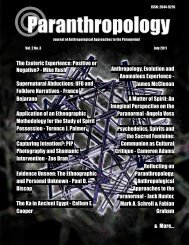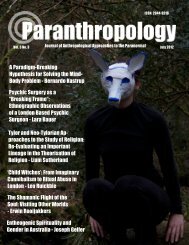Psi and Psychedelics - Paranthropology - Weebly
Psi and Psychedelics - Paranthropology - Weebly
Psi and Psychedelics - Paranthropology - Weebly
Create successful ePaper yourself
Turn your PDF publications into a flip-book with our unique Google optimized e-Paper software.
PARANTHROPOLOGY: JOURNAL OF ANTHROPOLOGICAL APPROACHES TO THE PARANORMAL VOL. 2 NO. 2<br />
the claims of the synthetic derivative of<br />
peyote as a psycho-chemical-religioussurrogate.<br />
Pahnke's intention had been to<br />
investigate the similarities <strong>and</strong> differences<br />
between experiences described by mystics<br />
<strong>and</strong> those induced by psychedelics (mindmanifesting)<br />
drugs such as LSD,<br />
psilocybin <strong>and</strong> mescaline. Working with<br />
subjects who had some prior religious<br />
predisposition Pahnke used scientific<br />
methodology including a detailed<br />
questionnaire. The questionnaire was<br />
based upon the following well established<br />
typology of mysticism:<br />
Unity - a sense of cosmic oneness<br />
Transcendence of Time <strong>and</strong> Space<br />
Deeply Felt Positive Mood<br />
Sense of Sacredness<br />
Noetic Quality - a feeling of insight or<br />
illumination<br />
Paradoxicality - A person may realize that<br />
he/she is experiencing, for example, "an<br />
identity of opposites," yet it seems to<br />
make sense at the time.<br />
Alleged ineffability<br />
Transiency - the experience passes<br />
Persisting Positive Changes in Attitudes<br />
<strong>and</strong> Behaviour<br />
The study was placebo controlled with<br />
one group taking the placebo while the<br />
study group took the drug. On the basis of<br />
their reported experiences Pahnke<br />
determined those subjects receiving<br />
psilocybin experienced phenomenon<br />
indistinguishable from, if not identical<br />
with, the categories defined by the<br />
typology of mysticism cited. From this<br />
experiment Pahnke was able to postulate<br />
"when subjected to a scientific<br />
experiment, these characteristics proved<br />
to be identical for spontaneous <strong>and</strong><br />
psychedelic mystical<br />
experiences" (Pahnke,1971). However,<br />
Pahnke maintained the psychedelic<br />
experience could be divided into five<br />
specific types: psychotic, psychodynamic,<br />
cognitive, aesthetic <strong>and</strong><br />
psychedelic ‘peak’ or mystical. Each<br />
condition manifested different phenomena<br />
ranging from intense, negative, dysphoric<br />
(psychotic) to those of the religious/<br />
mystical in form which were observed<br />
w i t h i n t h e p s y c h e d e l i c p e a k ,<br />
transcendental or mystical experience.<br />
It is important to note during an<br />
address to a public symposium on LSD<br />
<strong>and</strong> Religious Experience (1967), Pahnke<br />
stated his findings clearly demonstrated<br />
the psychedelic drug was only a trigger; a<br />
catalyst or facilitating agent. He suggested<br />
the type of experiences facilitated were<br />
largely dependent upon extra-drug<br />
variables such as preparation, setting <strong>and</strong><br />
the individual. Pahnke proposed content<br />
of the experience was impossible to<br />
predict <strong>and</strong> psychotic reactions were<br />
easier to produce than mystical<br />
experiences, of which there was no<br />
certainly even under the most optimal<br />
conditions. (1967:2)<br />
In a 2006 replication of Pahnke's<br />
experiment using the same methodology<br />
(including the Pahnke-Richards Mystical<br />
Experience Questionnaire) a rigorous<br />
study was carried out by Griffiths,<br />
Richards, McCann & Jesse of the Johns<br />
Hopkins University School of Medicine.<br />
The results were published in a research<br />
paper entitled '<strong>Psi</strong>locybin can occasion<br />
mystical-type experiences having<br />
substantial <strong>and</strong> sustained personal<br />
meaning <strong>and</strong> spiritual significance' in<br />
Psychopharmacology (2006).<br />
The paper presented a double-blind<br />
study that involved administering<br />
psilocybin under comfortable, structured,<br />
interpersonally supported conditions to<br />
volunteers who had reported regular<br />
45 PARANTHROPOLOGY: JOURNAL OF ANTHROPOLOGICAL APPROACHES TO THE PARANORMAL




